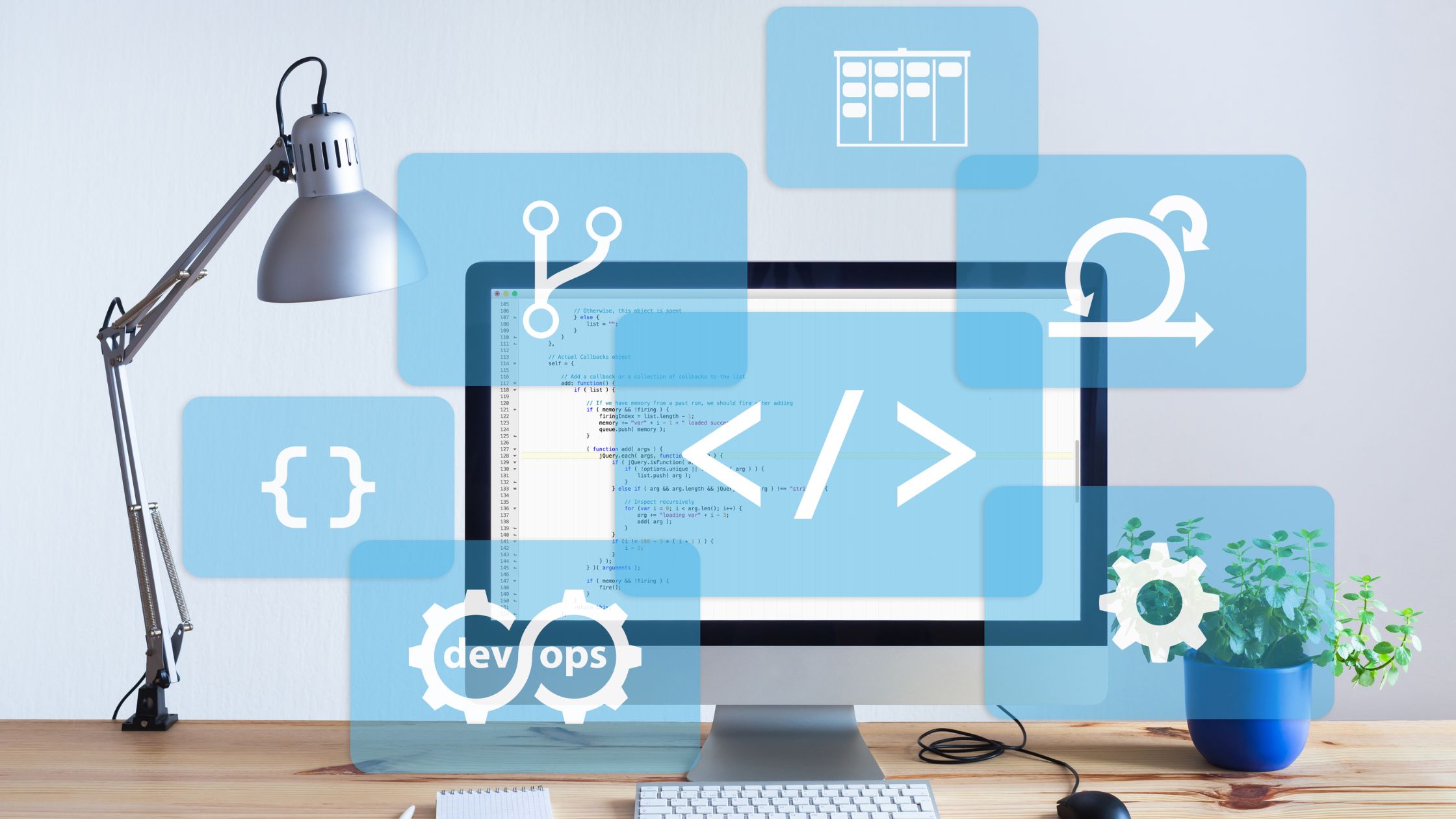MODIFIED ON: June 22, 2023 / ALIGNMINDS TECHNOLOGIES / 0 COMMENTS

Introduction
Organizations are constantly seeking ways to optimize their infrastructure management processes in the current digital world. Traditional manual approaches are no longer sufficient to meet the demands of modern software development and deployment. This is where Infrastructure as Code (IaC) and DevOps come into play, offering a powerful combination that enables seamless infrastructure management. In this article, we will explore the benefits of IaC and DevOps, understand their key principles, and learn how to implement them effectively.
What is Infrastructure as Code (IaC)?

Infrastructure as Code (IaC) is a methodology that allows infrastructure provisioning and management using code-based definitions. Instead of manually configuring servers and resources, IaC enables you to define your infrastructure in a declarative manner using scripts or configuration files. These scripts can be version-controlled, tested, and automated, providing a repeatable and reliable approach to infrastructure management.
What is DevOps Principles?
DevOps is a set of practices and principles that combines software development (Dev) and IT operations (Ops) to enhance collaboration, automate processes, and deliver high-quality software products. DevOps emphasizes the integration of development, testing, and operations teams to streamline the entire software delivery lifecycle. By breaking down silos and fostering cross-functional collaboration, DevOps enables organizations to achieve faster and more reliable deployments.
Benefits of Infrastructure as Code and DevOps
Implementing IaC and DevOps brings a wide range of benefits for organizations aiming to improve their infrastructure management processes. Let’s explore some of the key advantages:
A. Improved agility and scalability
IaC and DevOps enable organizations to quickly provision and scale their infrastructure as per their needs. With automated processes and infrastructure templates, you can easily spin up new environments, replicate existing configurations, and handle dynamic workloads efficiently. This agility allows teams to respond to changing business requirements swiftly.
B. Faster time to market
By automating manual tasks and streamlining processes, IaC and DevOps reduce the time it takes to deliver software products to the market. Continuous integration and continuous deployment (CI/CD) pipelines enable faster and more frequent releases, ensuring that valuable features reach the end-users promptly.
C. Enhanced collaboration and communication

DevOps emphasizes collaboration and communication among development, operations, and other stakeholders involved in the software delivery process. By breaking down barriers and fostering cross-functional teams, organizations can achieve better alignment, improved decision-making, and accelerated problem-solving.
D. Increased stability and reliability
With IaC and DevOps, infrastructure configurations are defined and managed through code, eliminating manual errors and inconsistencies. This results in more reliable and stable infrastructure deployments. Automated testing, monitoring, and observability practices further enhance stability by quickly detecting and resolving issues before they impact the end-users.
Challenges in IaC and DevOps Adoption
While the benefits of IaC and DevOps are compelling, organizations often encounter various challenges during the adoption process. Let’s explore some of these challenges in detail:
A. Addressing resistance to change
Change can be met with resistance, especially when it involves new technologies, processes, or cultural shifts. Introducing IaC and DevOps requires buy-in from all stakeholders, including developers, operations teams, and management. Overcoming resistance to change and fostering a culture of openness and collaboration is crucial for successful adoption.
B. Managing complexity and technical debt
As infrastructure and application architectures become more complex, managing the associated technical debt becomes a challenge. Over time, infrastructure code can become convoluted, making it difficult to understand, maintain, and scale. Organizations must find effective strategies to manage complexity and prevent technical debt from hindering the benefits of IaC and DevOps.
C. Ensuring security and compliance
As infrastructure becomes code, organizations must prioritize security and compliance. Failure to do so can lead to data breaches, compliance violations, and reputational damage. Ensuring secure infrastructure configurations, implementing appropriate access controls, and regularly auditing and monitoring the infrastructure are essential for maintaining a robust security posture.
D. Training and upskilling the workforce
Adopting IaC and DevOps often requires new skills and knowledge. Organizations must invest in training and upskilling their workforce to ensure they have the necessary expertise to effectively implement and maintain IaC and DevOps practices. Identifying skills gaps, providing relevant training programs, and encouraging continuous learning are crucial for building a capable and empowered team.
Unleashing Agility by Overcoming the Challenges in IaC and DevOps Adoption
While challenges exist, they can be overcome with proper strategies and approaches. Let’s explore some solutions to address the challenges faced during IaC and DevOps adoption:
A. Strategies for addressing resistance to change
Communicating the benefits of IaC and DevOps: Clearly articulate the advantages of IaC and DevOps, such as faster software delivery, improved collaboration, and increased scalability. Demonstrate how these practices align with the organization’s goals and can positively impact individual roles and responsibilities.
Involving key stakeholders in the decision-making process: Engage stakeholders from various departments in the decision-making process. This fosters a sense of ownership and involvement, increasing the likelihood of successful adoption and reducing resistance.
Providing training and support to employees: Offer comprehensive training programs to familiarize employees with IaC and DevOps concepts and tools. Provide ongoing support through coaching and mentoring, enabling employees to apply their newly acquired knowledge effectively.
B. Managing complexity and technical debt
Implementing modular and reusable infrastructure code: Break down infrastructure code into modular components that can be reused across projects. This promotes maintainability, scalability, and reduces complexity. Regularly reviewing and refactoring infrastructure code: Encourage developers to review infrastructure code regularly and refactor when necessary. This helps identify and address areas of complexity or technical debt, leading to cleaner and more efficient code.
Using automation tools to simplify deployment processes: Leverage automation tools, such as configuration management and orchestration frameworks, to simplify the deployment and management of infrastructure. Automation reduces the chances of human error and enables more reliable and consistent deployments.
C. Ensuring security and compliance

Incorporating security into the DevOps pipeline: Integrate security practices into the entire software delivery pipeline. Perform regular security scans, vulnerability assessments, and penetration testing to identify and address any potential security risks.
Implementing infrastructure security best practices: Follow industry-standard security best practices for infrastructure configuration. This includes implementing proper access controls, encryption, and monitoring mechanisms to protect sensitive data and ensure compliance with relevant regulations.
Regularly auditing and monitoring infrastructure configurations: Implement robust monitoring and auditing mechanisms to detect and respond to any unauthorized changes or potential security breaches. Continuously monitor infrastructure configurations to ensure compliance with security policies and industry standards.
D. Training and upskilling the workforce
Identifying skills gaps and training needs: Conduct skills assessments to identify areas where additional training and upskilling are required. Understand the specific roles and responsibilities within the organization and provide targeted training programs to address skill gaps.
Providing continuous learning opportunities: Encourage employees to participate in conferences, workshops, and online courses to stay updated with the latest IaC and DevOps practices. Foster a learning culture that supports continuous improvement and provides resources for self-directed learning.
Encouraging collaboration and knowledge sharing: Facilitate collaboration between teams by promoting cross-functional projects and encouraging knowledge sharing. Establish channels for sharing best practices, lessons learned, and innovative solutions to foster a culture of continuous learning and growth.
E. Teaming up with an Infrastructure development company

Teaming up with an infrastructure development company like Alignminds can be a game-changer when it comes to adopting Infrastructure as Code (IaC) and DevOps practices.
Alignminds is among the best Infrastructure development company in India, Kenya and US. They bring a wealth of expertise and experience in building robust and scalable infrastructure solutions. Their team of skilled professionals understands the complexities and challenges involved in IaC and DevOps adoption, and they are well-equipped to guide organizations through the entire process.
By partnering with Alignminds, organizations can benefit from their in-depth knowledge of industry best practices, cutting-edge tools and technologies, and a proven track record of successful implementations. Alignminds provides end-to-end solutions tailored to specific business needs, ensuring a smooth and efficient transition to IaC and DevOps.
With their support, organizations can overcome obstacles, mitigate risks, and accelerate the realization of the benefits associated with IaC and DevOps adoption.
So, what are you waiting for? Book a free consultation today! Contact Now!
Leave a reply
Your email address will not be published.
-
Recent Posts
- The Role of AI in Business Growth: Top Trends for 2025 and Beyond
- The Evolution of Voice Search in AI: What’s Next for 2025?
- How to Hire an AI Developer: A Complete Guide 2025
- Top 10 Android App Development Trends in 2025
- Top Trends in Product Modernization for 2025 and Beyond
-
Categories
- MVP Development (5)
- AlignMinds (56)
- Operating Systems (1)
- Android POS (3)
- Application Hosting (1)
- Artificial Intelligence (49)
- Big Data (2)
- Blockchain (1)
- Cloud Application Development (8)
- Software Development (39)
- Software Testing (9)
- Strategy & User Experience Design (4)
- Web Application Development (28)
- Cyber Security (6)
- Outsourcing (7)
- Programming Languages (3)
- DevOps (5)
- Software Designing (6)
- How to Code (4)
- Internet of Things (1)
- Machine Learning (2)
- Mobile App Marketing (5)
- Mobile Application Development (25)
- Mobile Applications (11)







